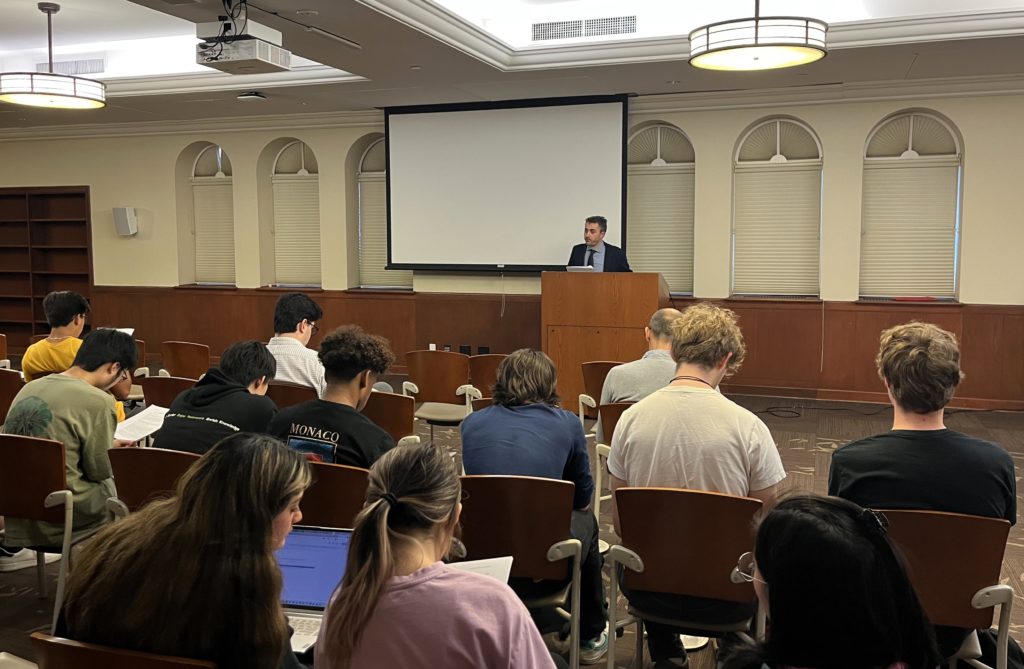With its hobbits and orcs, wizards and villains, rings and swords, the world created by J.R.R. Tolkien is a rather familiar one in today’s culture. Thanks in large part to the big screen success of productions like “The Lord of the Rings” and “The Hobbit,” and the more recent Amazon series “Rings of Power,” Middle-earth doesn’t feel so far away.
Less familiar, however, is an understanding of what its unabashedly Catholic creator was really up to. Tolkien’s mythology makes for good fantasy entertainment, but is that all he had in mind?
From Oct. 24-27, the University of Southern California welcomed perhaps the foremost Catholic Tolkien expert in academia, Oxford professor Giuseppe Pezzini, to unravel the threads of Catholicism woven into the fabric of Middle-earth.
What we got was an entirely new understanding of Tolkien as a storyteller. Instead of the old run-of-the-mill approach of reading Tolkien as an imaginative father telling his signature bedtime story, we were greeted with a view of Tolkien as a profound literary architect and critic.
Pezzini is a scholar of ancient languages (especially Latin) whose academic journey has included stops in Princeton, Pisa, the University of St. Andrews in Scotland, and finally Oxford, where Tolkien himself taught for decades. To mark the 50th year since Tolkien’s death, USC’s Nova Forum for Catholic Thought invited Pezzini for a weeklong speaking series on Tolkien’s literary contributions from a Catholic perspective.
The first of Pezzini’s lectures that I attended was titled “Beren and Frodo: Intra-textual Parallels, Internal Figuration, and the Universality of the Particular.” With a title like that, I walked in wondering whether I was lost.
But as the talk got underway, Pezzini’s words seemed to create a sense of unity among the diverse audience. It was as if we were all explorers, embarking on a collective journey into the heart of Tolkien’s literary universe, regardless how familiar we were with the source material.
He highlighted the recurring themes of moral choice, redemption, and the power of divine providence – “The Eagles are coming!” — that resonate throughout Tolkien’s stories. As any reader may know, these themes are pivotal in shaping the characters and events in Tolkien’s universe, but they came alive in each lecture.
In one talk, Pezzini connected Frodo, the central character in “The Lord of the Rings,” and his journey to destroy the One Ring to the Christian concept of vocation and “carrying the cross.” It was a revelation that not only deepened our understanding of Frodo but also underscored the universality of these themes that can resonate with people of all faiths.
At the heart of Tolkien’s storytelling, Pezzini argued, was the Catholic concept of “eucatastrophe,” a term coined by Tolkien himself. Eucatastrophe refers to the sudden, unexpected turn of events leading to a positive outcome, often described as the “sudden joyous ‘turn.’” Its use throughout Tolkien’s literature reflected his belief in the ultimate triumph of good over evil, echoing the Christian message of hope and resurrection.
It is well known that Tolkien’s faith and spirituality were at the core of his life, and they found a profound expression in his writings. But Pezzini’s expertise and perspective allowed us to glimpse the theology that quietly permeates Tolkien’s narratives which, as a Christian student in attendance, I found to be particularly moving.
Of course, it is common to recognize Tolkien’s stories, rooted in their inherent beauty and truth, as resounding with the essence of the Gospel. Yet, rather than aiming for a one-to-one metaphor or allegory of Christian theology, his work, as a creation of one who was created, naturally imitates the perfection and glory of our Creator. This idea — that Tolkien’s work or any work of beauty would, by default, be emblematic of the One True Beauty — is demonstrated by Pezzini’s research.
In another lecture, Pezzini explored a lesser-known short story by Tolkien, “Leaf by Niggle,” which follows the journey of an artist who attempts to paint a vast and intricate tree. Through Pezzini’s exposition, we came to understand that Niggle’s artistic endeavor mirrors the creative process itself and the artist’s relationship with his work. Moreover, the story deals with the concept of surrendering oneself to the ultimate criticism of the Creator, a note on which Pezzini established the literary criticism of Christ as paramount in the writer’s life.
This lecture in particular provided us with a meditation on the act of creation and its divine significance, challenging us to consider not only the stories we tell but also the purpose and judgment of the One Great Author, Christ himself. It was a compelling reminder that in the realm of creativity, there is a profound connection between the act of making and the One who created all — a concept that lingers in the heart long after the lecture ends.
By the time the lecture series was over, I left with a deeper appreciation for the universality of Tolkien’s writing and the impact of faith on his storytelling. I expect Pezzini's forthcoming book, an in-depth scholarly study of Tolkien’s literary theory scheduled for release early next year, to be a major contribution to Tolkien scholarship. Until then, however, my fellow Trojans and I left with an extraordinary revelation of what it means to be a Christian writer, artist, or any other kind of creative.
I came away from the series with a sense of renewed comfort. Being a “Christian creative,” Pezzini’s scholarship reminded us, is not confined to overt allegory or theological doctrine. Rather, it’s a deeper calling to breathe beauty and truth into our narratives, and act that glorifies and points to the ultimate Creator. This idea that, like Tolkien, we too can be vessels of a greater narrative that echoes the One Great Story was encouraging enough to send us off with full hearts and stimulated minds.

